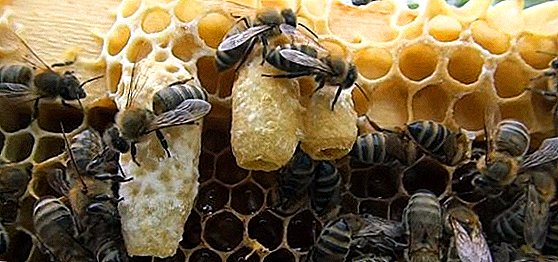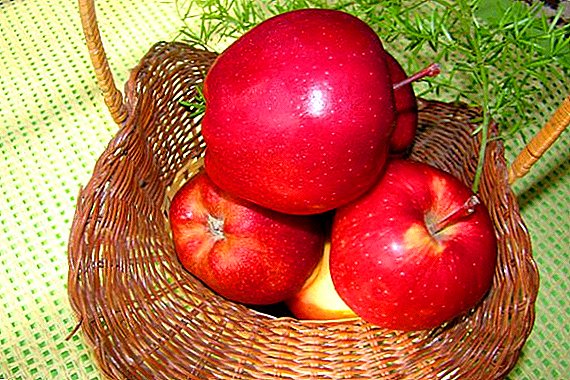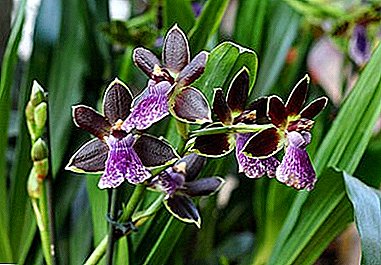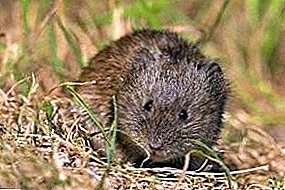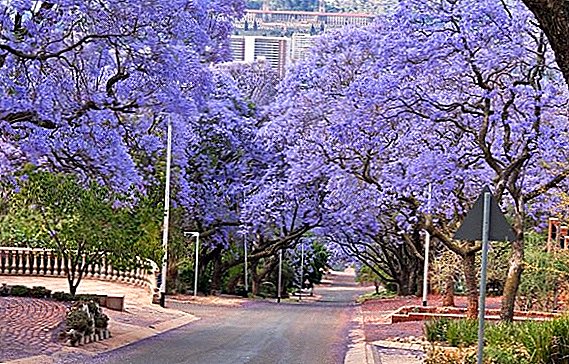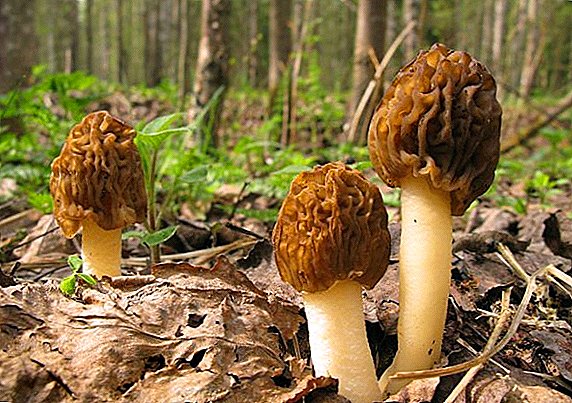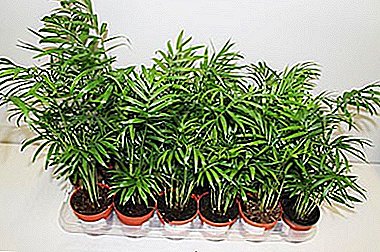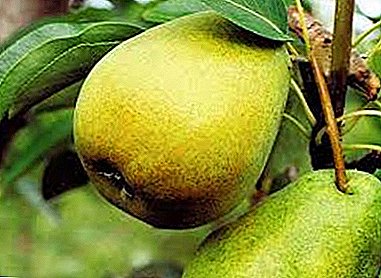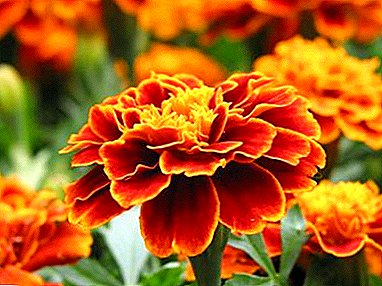
Marigolds or Chernobrivtsy is a plant of the Astrov family. The original habitat is America, from Arizona to Argentina. Pretty unpretentious in reproduction and care.
Mostly grown in open ground, but may be kept on a balcony or loggia. The most common are African marigold, French marigold and Mexican marigold.
Botanical description and history
Marigolds are a bush of upright, branched stems, 20 - 120 cm high. Leaves - from light green to dark green flowers, pinnately dissected, less often toothed with translucent glands. Leaf placement on the stem is opposite or alternate.
Inflorescences are regular or terry baskets of yellow, brown or orange color with a sharp, aster-like scent. Flowering time from early summer until frost. The root system is fibrous.
There are annual and perennial species. They spread throughout Europe and further after they were brought from America by the Spanish conquistadors in the 16th century. You can read about all types of this plant here.
Annuals or not?
The choice between annual and perennial depends on the purpose for which marigolds will land. Perennial suitable for long-term cultivation in one place, with an increase in the area that will occupy the plants by self-seeding. Besides, Every year marigold bushes are getting stronger and produce larger and lush flowers.
Annual plants require an annual planting, but there is more room for changes in landscape design. They can be planted not only in flowerbeds, but also in flowerpots, flowerpots, move them with pots where a sense of aesthetic balance will require. Is it possible to grow this beautiful flower at home in pots, we wrote in this article.
In addition, their new varieties appear much more frequently than perennial varieties. Even just By collecting the seeds of different varieties pollinated among themselves, you can get your own new hybrid. How to collect the seeds of marigolds, you will learn in this material.
Varieties of plants and photos
Below you can find a description of the appearance of marigold varieties and look at their photos.
Rejected or french
Comes from the highlands of Mexico. The name is due to the fact that their side shoots are always rejected. Grow low bushes up to 60 cm tall, consisting of upright shoots with dark green pinnately dissected leaves. Bloom from June to October.
Flowers double or semi-double 4 - 6 cm in diameter. Undemanding to the composition of the soil and feel good even on stony soils. Widely used for planting in front gardens and alpine slides.


Fine Leaf or Mexican
Grow bushes up to 50 cm from the branching from the base of the stems. Light green leaves pinnate, small and narrow. Flowers are golden, orange, red, yellow, up to 2 cm in diameter. Grow well even on heavily polluted soils and on roadsides. Leaves of some varieties are used in cooking.


Upright or African
Grow high bushes with a height of 30 cm to 1 meter. Stems are straight, ribbed with pinnately divided serrate leaves of all shades of green. Flowers from light yellow to dark orange with a diameter up to 13 cm. Well suited for growing for cutting.


All the details about what types of marigolds exist, you can find out in this article, and photos and descriptions of the most popular varieties can be found here.
Appearance and features
Perennial marigolds grow in compact bushes, consisting of upright, branched stems 20 - 130 cm high. Depending on the species, the leaves are pinnately dissected and pinnipid-separated in all shades of green.
Inflorescences consist of tubular and reed flowers. Depending on their form and number, they are usually divided into:
- simple (consisting of 1 - 3 rows of reed petals);
- semi-double (in their composition no more than half of the reed);
- terry (these colors are more than half either tubular or reed).
Flowers can be painted in yellow, orange, lemon, white, variegated, red-brown color. According to the total height of the bush marigolds are divided into:
- Giant - more than 90 cm.
- High - up to 60 cm.
- Sredneroslye - up to 50cm.
- Stunted - up to 40cm.
- Dwarf - up to 20cm.
Landing: rules and tips
In order for marigolds to develop normally, it is recommended to follow a number of rules for planting them in open ground.
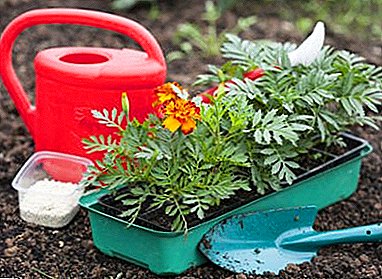 Planting flowers is better in the form of seedlings, and not just sowing seeds in open ground.
Planting flowers is better in the form of seedlings, and not just sowing seeds in open ground.- It is also worth waiting for when to establish a constant warm weather. Although these plants are not afraid of frost, but it is better to develop and will bloom when planted in open ground, when the constant spring heat comes.
- Depending on the variety, seedlings are planted at different intervals. For low varieties - 20 cm, for varieties of medium height - 30 cm, for high ones - 40 cm. Each plant is planted in a separate hole.
- After planting, they are well watered and adhere to the regime of abundant watering until the seedlings are strong.
Important. Abundant watering is very important for the further development of marigolds. In his absence, the bushes grow low, with a small number of shoots, and the flowers will be much smaller than they should be.
How to get a seedling of your favorite flower, we wrote in this article.
If the decision is made to plant a simple sowing, then there are two options. Seeds are planted either dry or pre-soaked in warm water for several days. All the details about growing marigolds from seeds can be found here.
- At the landing site make grooves 5 cm deep and moisturize them.
- Seeds are sown at a distance of 5 cm from each other.
- Filled beds are covered with earth or peat.
- After the appearance of a pair of true leaves, the sprouts swoop down and thin out. As a result, there should be a distance of 20 cm between plants, 40 cm for tall varieties.
- While the plants do not get stronger, they carry out abundant watering and regular weeding.
All the rules of landing marigolds you will find in this article, and how to do it at home and in the open field, read here.
Lighting
For landing pay attention to its light. Although it is allowed to plant in partial shade and shadow, it is better to plant these thermophilic flowers on areas that are well lit all day. In these areas, the water should not stagnate, since otherwise, the flowers begin to rot with fungal diseases of the roots.
Also, when choosing a place, the future height of the bush is important. Usually from undersized varieties form flower borders or planted on alpine slides. The remaining varieties are used as central elements of beds or planted in the background of the flower bed.
Soil requirements
In general, plants are quite unpretentious to the richness and density of the soil on which they grow. For best results, it is recommended to plant them in a neutral loamy soil, which is pre-enriched with minerals and trace elements. For better oxygen supply, they provide good drainage, for example, composting.
Important. You can pre-fertilize the soil with any full amount of mineral fertilizer, but you cannot use manure for this.
Care and selection of a place
With the right choice of the original landing site, with constant lighting, the care of the marigolds is not difficult, but they still require some attention.
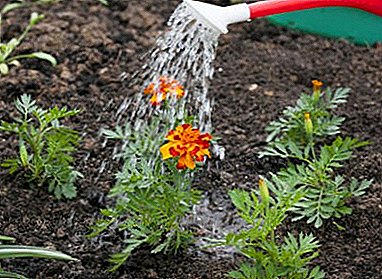 During the growing season, they need abundant watering without drying out the soil. During the flowering period, the frequency of watering is reduced and monitored so that there is no stagnant moisture in the soil.
During the growing season, they need abundant watering without drying out the soil. During the flowering period, the frequency of watering is reduced and monitored so that there is no stagnant moisture in the soil.- To improve the supply of oxygen to plants, the soil around them and between the rows is regularly loosened and weeds are removed.
- Lingering flowers are regularly removed and general forging pruning is performed. It is also recommended to remove most of the formed seed boxes. For further reproduction missing a few pieces.
- Three times a year they apply complex fertilizers: when they reach 10 cm in height, during the formation of buds and at the beginning of flowering. It is also recommended twice to conduct root feeding with phosphate-potassium fertilizers. This is done during the formation of buds and after the start of mass flowering. About how and how to feed the plant, read here, and what the flowers look like and what are the rules for caring for the plant during flowering and after it, we told here.
- For tall plants, props are installed so that they do not break when gusts of wind and from the severity of flowers.
- When the first frosts appear, the plants cover and leave until the spring.
Attention. Do not recommend the use of nitrogenous fertilizers, due to the fact that they enhance the growth of plant shoots, but at the same time inhibit the development of buds and inflorescences.
Common diseases and pests
- Gray rot formed if the summer is too rainy and cold, or when planting close to each other. It is characterized by dark brown spots on the stems and leaves. Upon detection, the infected plant is dug up and destroyed.
- Root rot appears as a result of stagnant moisture in the soil. It is treated with any phytoncides for plants.
- Slugs and snails begin to attack the plants at high humidity. Fight them by collecting them with their hands and installing open containers with bleach near the plants.
- Spider mite it appears if summer is dry and regular watering is not carried out. To destroy spray marigold infusions of onion, red pepper yarrow. Then, as a preventive measure, they are sprayed with plain water two to three times a day.
You can read about the diseases and pests of the flower here, and we wrote about the methods of dealing with the most common diseases and insects in this material.
Breeding
 Perennial marigolds are able to multiply by self-sowing, and if there is no need to harvest the seeds, then a certain number of seed pods are simply left on the bushes. In the future, they will open themselves and the seeds will fall to the ground.
Perennial marigolds are able to multiply by self-sowing, and if there is no need to harvest the seeds, then a certain number of seed pods are simply left on the bushes. In the future, they will open themselves and the seeds will fall to the ground.
The easiest way of reproduction is by dividing the mother bush. An excavated bush is simply divided into several parts with roots and stems. Then they are planted separately according to the rules of landing.
In general, we can say that marigolds are a good choice for beginner gardeners as well as experienced gardeners and landscape designers.
A large selection of varieties and unpretentiousness in cultivation and care, make it easy to decorate with them both the urban flowerbed and the front garden of a private house or cottage. And gardeners will love the fact that their smell will scare off harmful insects from vegetable beds.


 Planting flowers is better in the form of seedlings, and not just sowing seeds in open ground.
Planting flowers is better in the form of seedlings, and not just sowing seeds in open ground. During the growing season, they need abundant watering without drying out the soil. During the flowering period, the frequency of watering is reduced and monitored so that there is no stagnant moisture in the soil.
During the growing season, they need abundant watering without drying out the soil. During the flowering period, the frequency of watering is reduced and monitored so that there is no stagnant moisture in the soil.